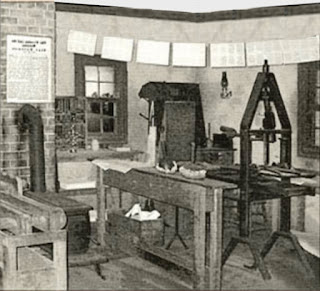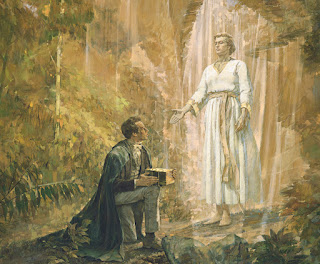Continued from the previous post, regarding the different opinions and attitudes theorists have about correlating their beliefs with the scriptural record.
Comment: “The early Saints referred to the hill in Manchester as the Hill Cumorah, which should show that the tradition was correct, and that the Saints’ communal interpretation of history influenced Joseph’s descriptions of that history. Joseph not only allowed the communal creation of the hill name but embraced it."
Response: First of all, the early Saints only began calling the hill in Manchester, “Cumorah” after Oliver Cowdery’s publication of his Letter VII to William W. Phelps in July, 1835, five years after the Church was organized. Prior to that it had no name and was referred to in many ways as we have discussed earlier. Second, as far as we know, Joseph Smith never embraced the name or term Hill Cumorah for the hill in New York—had he, there would be some record of it. In fact, as said earlier, he never referred to it as anything other than “the hill where the plates were buried,” or just plain “the hill.” Generally, even when talking to his immediate family, he used only the term “the hill” when referring to the hill in Manchester.
This is seen on the occasions where Joseph had perfect opportunity to expand on the hill and its name, if any. The fact that it was “the hill” to him might be sufficient to assume that he did not think of it as having any name at all. And as for members calling it the hill Cumorah, he still did not use that name, but continued to call it “the hill.”
All of Oliver Cowdery’s letters to W.W.Phelps were first published in the “Messenger and Advocate” newspaper which replaced the Evening and Morning Star that was destroyed by a mob in Independence, Missouri
Comments: “Phelps writings which he published, show an understanding of the work Joseph accomplished. As he wrote: ‘It was translated by the gift and power of God, by an unlearned man, through the aid of a pair of Interpreters, or spectacles-(known, perhaps, in ancient days as Teraphim, or Urim ["lights"] and Thummim ["perfections]. Therefore, it is plausible that just as Phelps was the one to associate the interpreters with Urim and Thumim of the Bible, one of Joseph’s companions made the association between the hill from which the plates were taken with the hill in which Mormon had hid the plates—how did he know that unless Joseph told him.”
Response: It is interesting that theorists often leave out of a statement, they are quoting, the rest of a statement because it does not agree with their point of view. As the case of William W. Phelps, in the statement of how Joseph translated the plates, the theorist did not complete the last sentence, which read: “There is no evidence of anyone publishing speculation about the association of the hill in New York with Cumorah in the Book of Mormon.”
It is evident here that the theorist is confusing Cowdery’s testimony of the translation process with Cowdery’s opinion about the hill Cumorah. These are two entirely different issues, which he lumps together. One can accept Cowdery’s factual testimony of the translation process, yet still disagree with his opinion of Cumorah in New York being the hill Cumorah of the scriptural record—just like one can disagree with his 1838 statement that the Lord told him the Church was in error and the leaders were all falling away from the truth, but accept his testimony about the truthfulness of the Church as it appears in the introductory pages of the Book of Mormon (See “Testimony of Jacob Gates,” Improvement Era, March 1912, pp418–419. Elder Gates was later one of the seven Presidents of the Seventy in the Church, from 1862 to 1892; also see David H. Cannon, Autobiography, 13 March 1917, 5; photocopy of holograph in possession of BYU professor Richard Lloyd Anderson).
1907 photo of the low-lying drumlin hill that is about three miles southeast of the Smith farm along the Manchester-Palmyra border in western New York. In Joseph’s time the north end was covered with grass, the south with scattered timber and forests
Another statement by Joseph Smith that became widespread knowledge of an event that happened in 1827. “On the west side of this hill, not far from the top, under a stone of considerable size, lay the plates, deposited in a stone box.” Again, “The messenger . . . told me that I should come to that place precisely in one year from that time, and that he would there meet with me, and that I should continue to do so until the time should come for obtaining the plates.”
Joseph further described the hill as “Convenient to the village of Manchester, Ontario county, New York, stands a hill of considerable size, and the most elevated of any in the neighborhood. On the west side of this hill, not far from the top, under a stone of considerable size, lay the plates, deposited in a stone box (Joseph Smith—History 1:51).
Joseph also said, “On the twenty-second day of September, one thousand eight hundred and twenty-seven, having gone as usual at the end of another year to the place where they were deposited, the same heavenly messenger delivered them up to me (Joseph Smith—History 1:59.)
All of these were written after 1839—certainly by then the hill was called “Cumorah” by most of the early members, but Joseph Smith still referred to it merely as “the hill.”
An earlier comment made by Joseph Smith in1838, bears this out, which was printed in the “Answers to Questions,” Elders’ Journal of the Church of Jesus Christ of Latter Day Saints (July 1838): pp42-43, which reads:
Moroni instructs Joseph regarding the plates on the hill in Manchester New York
Question 4th. How, and where did you obtain the book of Mormon?
Answer. Moroni, the person who deposited the plates, from whence the book of Mormon was translated, in a hill in Manchester, Ontario County New York, being dead; and raised again therefrom, appeared unto me, and told me where they were; and gave me directions how to obtain them (emphasis added).
Comment: “There are two major issues that support the hill in New York being the same as that found in the Book of Mormon: 1] Oliver Cowdery claimed the two Cumorah hills were one in the same, and located near Palmyra, New York; and 2] David Whitmer claims to have heard Moroni saying he was going to the hill Cumorah when stopped along the road.”
Response: First, the road indicated was the route to Fayette (from Harmony Pennsylvania), and Secondly, David Whitmer, said immediately afterward and 58 years later that the person Joseph Smith identified as the angel Moroni, that “he was going to Cumorah.” No “hill” was mentioned, though Heartland and Great Lakes theorists love to insert “hill Cumorah,” in this story of Joseph Smith and Oliver Cowdery, along with David Whitmer going to Fayette. They were driving a horse-drawn wagon along a deserted country road and came upon a man walking in the same direction. David looked to Joseph for instruction and Joseph told David to offer the man a ride, but the man declined and stated that he was heading to Cumorah. At the time, the name Cumorah was not known to David, so he turned to Joseph for an explanation. When David looked back the man had disappeared. Upon inquiry, Joseph identified the man as Moroni and Joseph told the others that Moroni was safely transporting the plates to the Whitmer Farm in Fayette and would return the plates to Joseph once they arrived.”
The hill in Manchester people since Joseph Smith’s time called the Hill Cumorah. It is a low-lying drumlin hill, and does not match Mormon’s descriptions
There simply was no mention of a hill. Nor do we know what Moroni meant by the singular term Cumorah. As an example, the term Cumorah, as used in the scriptural record applies to two physical locations: 1) the Land of Cumorah, and 2) the Hill Cumorah. If Moroni meant the hill, he did not say so, and it would be in opposition to what Joseph Smith said Moroni told him, and if he meant the hill, why didn’t’ he say so—and why would he be going there since it was 30 miles beyond Fayette (and not even on a direct line) where Joseph said he was going. Is it possible the term “Cumorah” meant something else to Moroni that is unknown to us? Or, if he meant the land of Cumorah, then Fayette might possibly have been within that area that Moroni knew as the Land of Cumorah in his mortal lifetime (Mormon 6:2).
The point is, we simply do not know and the statement cannot be used to support a claim that the hill Cumorah in New York being the same hill as that stated in the scriptural record.
Therefore, what is the point of these two unsubstantiated claims as well as their purpose in repeatedly citing them since one claim is strictly an opinion, and the other is without explanation or purpose in light of Joseph Smith saying Moroni told him he was heading to Fayette, making the hill Cumorah incorrect from what Moroni said.
(See the next post, “Who Said What, and What Did They Mean? – Part IV,” for more of the comments made by theorists regarding their interpretation of the meaning)








My theory is that this is a deliberate stumbling block, and when we learn the language we will see shake our heads in amazement as to how could we not see it before.
ReplyDeleteIn the same way Eternal punishment is God's punishment.